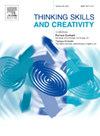考夫曼创造力领域量表的验证和网络结构:阿拉伯语环境下的心理测量调查
IF 3.7
2区 教育学
Q1 Social Sciences
引用次数: 0
摘要
考夫曼创造力领域量表(Kaufman Domains of Creativity Scale,简称 K-DOCS)是一种自我报告量表,旨在反映不同领域的创造性行为,已在不同文化背景下得到使用和验证。本研究旨在评估阿拉伯语版 K-DOCS 的心理测量特性。通过探索性图表分析、确认性因素分析和项目反应理论分析,对 K-DOCS 的因素结构进行了评估。此外,还评估了 K-DOCS 与开放性和情商测量的标准有效性。除了验证之外,研究还检验了 K-DOCS 各领域的网络结构,以了解它们之间的相互联系,并调查了基于性别、年龄和专业的潜在领域网络差异。研究收集了 2594 名埃及大学生的数据。结果表明,K-DOCS 的五因素结构与理论因素结构基本一致,并显示出可接受的标准效度。研究结果进一步表明,K-DOCS 的各个领域聚集成一个相互联系的群体,不同性别和年龄的学生在领域连接性方面存在显著差异,而不同专业的学生在领域连接性方面则不存在显著差异。本文讨论了这些结果对创造力概念化和测量的影响。本文章由计算机程序翻译,如有差异,请以英文原文为准。
Validation and network structure of the Kaufman domains of creativity scale: A psychometric investigation in an Arabic context
The Kaufman Domains of Creativity Scale (K-DOCS), a self-report measure designed to capture creative behaviors across various domains, has been utilized and validated across different cultural contexts. The present study sought to assess the psychometric properties of an Arabic version of the K-DOCS. Using exploratory graph analysis followed by confirmatory factor analysis and item response theory analysis, the factor structure of the K-DOCS was assessed. Additionally, the criterion validity of the K-DOCS was assessed in relation to measures of openness and emotional intelligence. Beyond validation, the study examined the network structure of the K-DOCS domains to understand their interconnections and investigated potential domain network differences based on gender, age, and academic major. Data were collected among 2,594 Egyptian university students. The results suggest that the K-DOCS has a five-factor structure broadly consistent with the theoretical factor structure and demonstrates acceptable criterion validity. The results further reveal that the K-DOCS domains cluster together into a single interconnected community, with significant differences in domain connectivity based on gender and age, but not on academic major. The implications of these results for the conceptualization and measurement of creativity are discussed.
求助全文
通过发布文献求助,成功后即可免费获取论文全文。
去求助
来源期刊

Thinking Skills and Creativity
EDUCATION & EDUCATIONAL RESEARCH-
CiteScore
6.40
自引率
16.20%
发文量
172
审稿时长
76 days
期刊介绍:
Thinking Skills and Creativity is a new journal providing a peer-reviewed forum for communication and debate for the community of researchers interested in teaching for thinking and creativity. Papers may represent a variety of theoretical perspectives and methodological approaches and may relate to any age level in a diversity of settings: formal and informal, education and work-based.
 求助内容:
求助内容: 应助结果提醒方式:
应助结果提醒方式:


